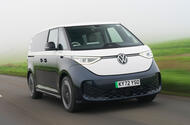
After more than two decades of teasing, Volkswagen has finally reinvented the van beloved by so many communities
In 2022, Volkswagen’s effort to electrify its model range resulted in the launch of a new, different and vaguely recognisable kind of electric family car, and unlike the brand's other ID cars so far (which have spawned Audi, Cupra and Skoda siblings), this one is VW-only.Its electric cars are proving popular thanks to their diversity, but none are more unique than this: the Volkswagen ID Buzz.  The ID Buzz, says the brand, is “the new face of future-orientated, sustainable family mobilityâ€, and has the lofty goal of tempting families with active lifestyles – and some with longer memories and more sentimental tendencies, perhaps – to convert to electric. In principle, and leaving aside how it’s powered, the Buzz is a full-size monocab MPV of a kind that found favour on our roads 20 years ago but has since fallen out of it.Call it a ‘minibus’ if you like, but it’s unlike key rivals because it adopts a relatively sophisticated passenger car platform rather than being adapted from a commercial vehicle.You might be more inclined to call it a ‘microbus’, of course, or a ‘hippy van’. The Buzz’s name is a play on that of VW’s famous Type 2 ‘Bus’ of 1949, which inspired a cult following that lasted decades and permeated popular culture widely.So can the new Buzz achieve something similar, so many years later, for a new generation?Volkswagen ID Buzz range at a glanceWith the arrival of the long-wheelbase ID Buzz and the more powerful, all-wheel drive ID Buzz GTX, the model’s range has expanded substantially compared to its launch. The range starts with the standard short-wheelbase ID Buzz, which has five seats and a cavernous boot. But the long-wheelbase model is where the ID Buzz finally reveals its full potential as a proper, people-carrying MPV. The additional space is more evident on the inside. It comes with seven seats as standard in a 2/3/2 configuration, while a 2/2/2 six-seat one or a 2/3 five-seat one can also be selected. With the seven-seat option, the third row of seats can be removed to create a 1340-litre cargo space – an increase of 219 litres over the SWB.There’s also the ID Buzz Cargo, a commercial vehicle version of the electric MPV with a more traditional van layout. It features a 2+1-seat cab and black bumpers, with a lower equipment specification. Volkswagen offers the ID Buzz with a choice of two specification levels, Life and Style, with prices starting from just under £60,000. Life models feature 10-colour ambient lighting, wireless Apple CarPlay and Android Auto, sat-nav, a reversing camera, a heated steering wheel and heated front seats.Style models get 30-colour ambient lighting, an electric tailgate, more powerful, automatic headlights, a multi-flex boot board load-bay divider, and 20in alloy wheels. The Buzz comes with a choice of batteries and motors, which we’ve listed in the table below. The LWB ID Buzz introduced a new 79kWh battery and more powerful 282bhp motor, which arrived following the uprated Volkswagen ID 4. The ID Buzz GTX sits at the top of the range, with an eye-popping 335bhp, all-wheel drive, and a host of sporty design details. You can read our Volkswagen ID Buzz GTX review here.VersionPowerID Buzz SWB 77kWh Pro201bhpID Buzz LWB 79kWh Pro282bhpID Buzz LWB 86kWh Pro282bhpID Buzz GTX SWB335bhpID Buzz GTX LWB335bhpID Buzz Cargo Commercial 77kWh201bhp

